What are Tree Swallow nest box grids?
- What’s better than one pair of nesting Tree Swallows? Lots of swallows nesting in together in Tree Swallow nest box grids!
- You’ll find nest box grids mentioned elsewhere on this web site, but since grids are one of the neatest things you can do with Tree Swallows we think the topic deserves a short page of its own.
- The shot below shows a small section of our own Tree Swallow nest box grid.
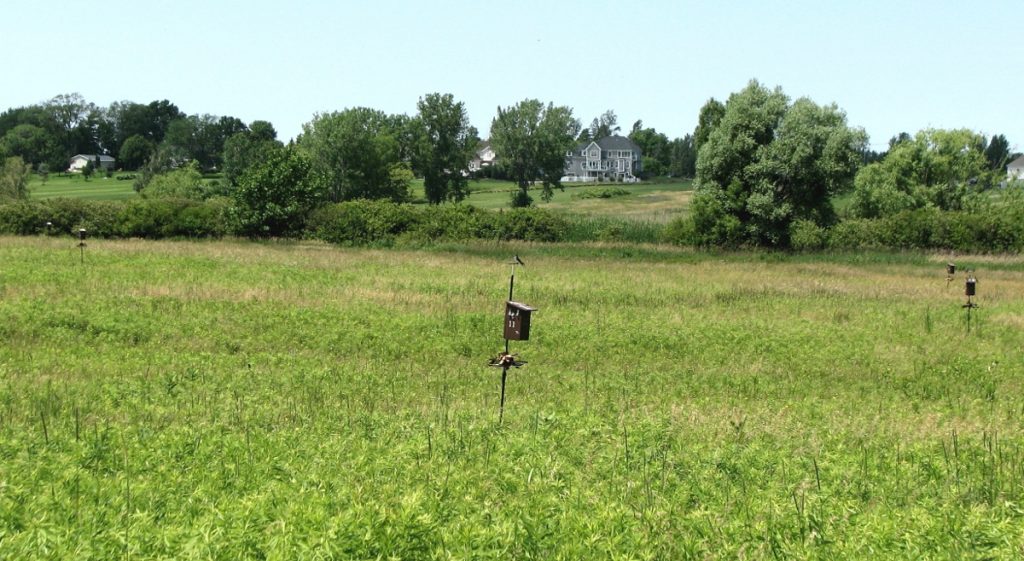
- We define a Tree Swallow nest box grid as a group of pole-mounted swallow boxes, spaced at regular intervals, out in an open field, as in the diagram below.
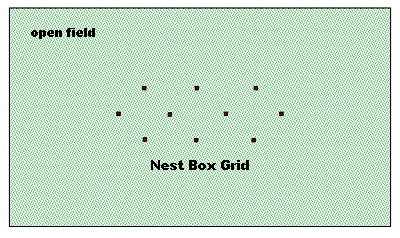
- Unlike many birds, Tree Swallows don’t defend large feeding territories surrounding their nests.
- Since Tree Swallows defend only their nest and a small area around it you can accommodate many nesting pairs in one field.
- So, if you find a suitable site you could try setting up a nest box grid for Tree Swallows. See Finding Sites for Tree Swallow Nest Box projects.
How far apart should Tree Swallow boxes be spaced in grids?
- Spacing doesn’t have to be exact.
- However, in our opinion, boxes for Tree Swallow ought to be at least 100 feet or 28 meters apart. Farther apart is even better if you have the space.
- Closer spacing tends to increase squabbling among adult swallows, which may result in loss of eggs and young or even death of adults.
- The diagrams below show approximate box spacing in feet (at left) and meters (at right).
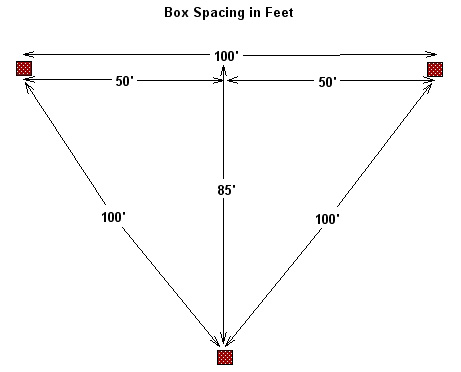
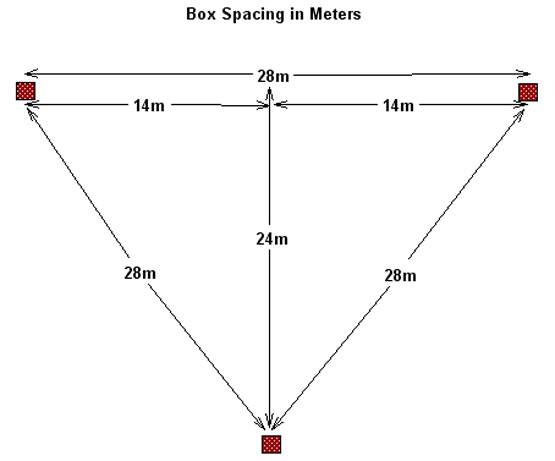
How can you measure distances out in the field?
- At home, determine your average pace or footstep length, so you can use number of paces to measure rough distances in the field.
How far from field borders should boxes in Tree swallow nest box grids be placed?
- Boxes placed far out in fields are less apt to be found by mammalian predators.
- Try to keep swallow boxes at least 150 feet or 50 meters away from field edges.
- For more see Placing Tree Swallow Boxes.
How many boxes can go in a Tree Swallow nest box grid?
- Habitat quality for Tree Swallows and field size are important factors limiting the potential number of boxes in your grid.
- In general we think it’s best to start with a relatively small number of boxes and observe swallow nesting success over a couple of seasons. If the results are good you can consider expansion.
- Over the years we’ve operated five swallow box grids, with from six to twenty-four boxes each. Our current grid usually starts each year with 8 boxes. However, during the season boxes added to reduce competition push the eventual number considerably higher.
- Our grid is in excellent habitat and could easily be expanded to 50 or more boxes, but we try not to exceed 25. We feel doing so might reduce the overall food supply and have too much impact on prey species.
- To view a YouTube video of our Salmon Creek Tree Swallow Grid click here.
- The satellite view below is of our grid at 43.308N by 77.736W in the Braddock Bay Wildlife Management Area of NY. Red dots are approximate locations of a season’s first set of boxes.
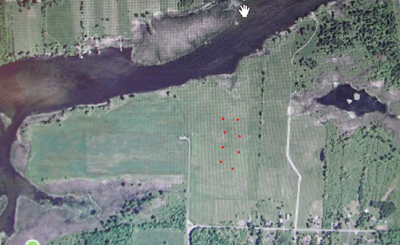
- Tree Swallow grids of 100 boxes or more are often established for scientific research, where size of data samples is an important concern. The willingness of Tree Swallows to nest in these very large associations has made this species a favorite among ornithologists.
- See Tree Swallows in Research to learn the valuable contributions of this species to our knowledge of birds in general.
Will other kinds of birds may try to nest in Tree Swallow grids?
- It’s not unusual for Bluebirds to claim boxes, even in very large Tree Swallow grids.
- If House Wrens show interest the boxes are too close to trees or shrubs and should be relocated. See Reducing House Wren Damage to Tree Swallow Nestings.
- If House Sparrows investigate or intrude on boxes, don’t wait. Move the boxes farther from houses, barns, or other buildings. See House Sparrow Damage to Tree Swallow Nestings.
Doesn’t grouping nest boxes make them more vulnerable to predators?
- Yes, it can, if you don’t place your boxes carefully and don’t protect them.
- If predators, especially raccoons, find and predate one nest box in a grid there is a real danger that they will search for other nearby boxes. They may move from box to box, killing and eating young and adult birds as they go. As a result, entire grids can be wiped out.
- Please use caution locating boxes and use predator guards with all your boxes, whether placed alone or in grids. See the next step, below.
Next Step: Protecting Boxes from Predators
———————————————————————————
Home: Tree Swallow Nest Box Projects
Creating Tree Swallow Nest Box Projects
Spring Return
Nesting Season Behavior
Song and Calls
Nest Site Claiming
Pair Formation
Nest Building
Bird Flight
Mating and Paternity
Diary of One Season at Salmon Creek
Monitoring Nest Boxes and Keeping Records
Making Box Checks Keeping Box Records Control Sheets Season Summaries Print Sheets
Banding Your Tree Swallows Banding Adults Banding Nestlings
Tree Swallows in Research Research Bibliography Glossary of Terms